Influence of the Preformed Coil Design on the Thermal Behavior of Electric Traction Machines
Abstract
:1. Introduction
- Insulation system,
- thermal behavior, and
- electromagnetic behavior.
2. Simulation Methodology
2.1. Electromagnetic Simulation
2.2. Thermal Lumped Parameter Model
2.3. Thermal Finite Element Analysis
3. Measurement Setup
4. Results
4.1. Comparison of Simulated and Measured Efficiency and Losses
4.2. Influence of Winding Design on Measured Transient Temperature Curves
- The 2D-LPTN and the 2D-FEA show good agreement with a maximum temperature deviation of .
- The 3D-LPTN and the transient test bench measurements show a very good agreement with a maximum deviation of .
- A parameterization of all models was possible under consideration of several boundary conditions that ensure a high degree of comparability.
- The maximum winding temperature of the preformed coil design at the transient operation of OP1 for is approximately lower than the winding temperature of the round wire design.
- The disadvantage of the increased winding losses of the preformed coil design at an operational point with maximum speed (OP4: ) is outperformed by the improved heat transfer path.
4.3. Comparison of the Influence of Reduced Losses and Improved Heat Extraction Path
- (1)
- Influence on the average temperature in the slot: The improved heat path (from a to b) shows a reduction of and the reduced losses (from b to c) of . The reduced losses have a slightly higher potential of improvement.
- (2)
- Influence on the maximum temperature in the slot: The improved heat transfer path (from a to b) reduces the maximum temperature by , the reduced losses (from b to c) by . The improved heat path has a more significant influence on the maximum temperature.
4.4. Influence of Winding Design on the Operational Limits of the Machine
- For the round wire design, the simulated S1-power is larger than the measured S1-power of at .
- For the preformed coil design, the simulated S1-power of is larger than the measured S1-power of at .
- According to the measurement, the S1-power of the preformed coil design at is increased by in comparison to the round wire design.
- According to the simulation, the S1-power of the preformed coil design at is increased by in comparison to the round wire design.
- Be aware that the given results of the S1-power are calculated based on the temperature limitations caused by the stator winding. Restrictions for the temperature of the permanent magnets in the rotor are likely to occure for high rotational speed [12].
5. Discussion
6. Conclusions
Author Contributions
Funding
Data Availability Statement
Acknowledgments
Conflicts of Interest
Abbreviations
| ac | alternating current |
| dc | direct current |
| FEA | Finite Element Analysis |
| LPTN | Lumped Parameter Thermal Network Model |
| MTPA | Maximum Torque per Ampere |
| OP | Operational Point |
References
- Stenzel, P.; Dollinger, P.; Richnow, J.; Franke, J. Innovative needle winding method using curved wire guide in order to significantly increase the copper fill factor. In Proceedings of the 17th International Conference on Electrical Machines and Systems (ICEMS), Hangzhou, China, 22–25 October 2014; pp. 3047–3053. [Google Scholar]
- Zhao, Y.; Li, D.; Pei, T.; Qu, R. Overview of the rectangular wire windings AC electrical machine. CES Trans. Electr. Mach. Syst. 2019, 3, 160–169. [Google Scholar] [CrossRef]
- Bianchini, C.; Vogni, M.; Torreggiani, A.; Nuzzo, S.; Barater, D.; Franceschini, G. Slot Design Optimization for Copper Losses Reduction in Electric Machines for High Speed Applications. Appl. Sci. 2020, 10, 7425. [Google Scholar] [CrossRef]
- Aoyama, M.; Deng, J. Visualization and quantitative evaluation of eddy current loss in bar-wound type permanent magnet synchronous motor for mild-hybrid vehicles. CES Trans. Electr. Mach. Syst. 2019, 3, 269–278. [Google Scholar] [CrossRef]
- Berardi, G.; Nategh, S.; Bianchi, N.; Thioliere, Y. A Comparison between Random and Hairpin Winding in E-mobility Applications. In Proceedings of the 46th Annual Conference of the IEEE Industrial Electronics Society (IECON), Singapore, 18–21 October 2020; pp. 815–820. [Google Scholar]
- Liu, C.; Xu, Z.; Gerada, D.; Li, J.; Gerada, C.; Chong, Y.C.; Popescu, M.; Goss, J.; Staton, D.; Zhang, H. Experimental Investigation on Oil Spray Cooling with Hairpin Windings. IEEE Trans. Ind. Electron. 2020, 67, 7343–7353. [Google Scholar] [CrossRef]
- Venturini, G.; Volpe, G.; Villani, M.; Popescu, M. Investigation of Cooling Solutions for Hairpin Winding in Traction Application. In Proceedings of the International Conference on Electrical Machines (ICEM), Gothenburg, Sweden, 23–26 August 2020; pp. 1573–1578. [Google Scholar]
- Pauli, F.; Groschup, B.; Schröder, M.; Hameyer, K. High Torque Density Low Voltage Traction Drives with Preformed Coils: Evaluation of Operation Limitations. In Proceedings of the 10th International Electric Drives Production Conference (EDPC), Ludwigsburg, Germany, 8–9 December 2020; pp. 1–7. [Google Scholar]
- Reinap, A.; Andersson, M.; Marquez-Fernandez, F.J.; Abrahamsson, P.; Alakula, M. Performance Estimation of a Traction Machine with Direct Cooled Hairpin Winding. In Proceedings of the IEEE Transportation Electrification Conference and Expo (ITEC), Detroit, MI, USA, 19–21 June 2019; pp. 1–6. [Google Scholar]
- Petrell, D.; Teller, M.; Hirt, G.; Börzel, S.; Schäfer, W. Manufacturing of Conically Shaped Concentrated Windings for Wheel Hub Engines by a Multi-Stage Upsetting Process. In Proceedings of the 2019 9th International Electric Drives Production Conference (EDPC), Esslingen, Germany, 3–4 December 2019; pp. 1–7. [Google Scholar]
- Petrell, D.; Teller, M.; Hirt, G.; Börzel, S.; Schäfer, W. Economical Production of Conically Shaped Concentrated Windings Using Forming Technology in Wheel Hub Drives. In Proceedings of the 10th International Electric Drives Production Conference (EDPC), Ludwigsburg, Germany, 8–9 December 2020; pp. 1–7. [Google Scholar]
- Groschup, B.; Komissarov, M.; Stevic, S.; Hameyer, K. Operation Enhancement of Permanent Magnet Excited Motors with Advanced Rotor Cooling System. In Proceedings of the IEEE Transportation Electrification Conference and Expo (ITEC), Detroit, MI, USA, 19–21 June 2019; pp. 1–6. [Google Scholar]
- Boglietti, A.; Cavagnino, A.; Staton, D.; Shanel, M.; Mueller, M.; Mejuto, C. Evolution and Modern Approaches for Thermal Analysis of Electrical Machines. IEEE Trans. Ind. Electron. 2009, 56, 871–882. [Google Scholar] [CrossRef] [Green Version]
- Du-Bar, C.; Wallmark, O. Eddy Current Losses in a Hairpin Winding for an Automotive Application. In Proceedings of the 2018 XIII International Conference on Electrical Machines (ICEM), Alexandroupoli, Greece, 3–6 September 2018; pp. 710–716. [Google Scholar]
- Schmidt, D.; van der Giet, M.; Hameyer, K. Improved iron-loss prediction by a modified loss-equation using a reduced parameter identification range. In Proceedings of the 20th International Conference on Soft Magnetic Materials (SMM), Mpenou, Kos Island, Greece, 18–22 September 2011; p. 421. [Google Scholar]
- Eggers, D.; Steentjes, S.; Hameyer, K. Advanced Iron-Loss Estimation for Nonlinear Material Behavior. IEEE Trans. Magn. 2012, 48, 3021–3024. [Google Scholar] [CrossRef]
- Steentjes, S.; Eggers, D.; Leßmann, M.; Hameyer, K. Iron-loss model for the FE-simulation of electrical machines. In Proceedings of the INDUCTICA Technical Conference, Berlin, Germany, 26–28 June 2012; Monkman, G., Ed.; pp. 239–246. [Google Scholar]
- Staton, D.; Boglietti, A.; Cavagnino, A. Solving the More Difficult Aspects of Electric Motor Thermal Analysis in Small and Medium Size Industrial Induction Motors. IEEE Trans. Energy Convers. 2005, 20, 620–628. [Google Scholar] [CrossRef] [Green Version]
- Boglietti, A.; Cavagnino, A.; Staton, D.A. Determination of Critical Parameters in Electrical Machine Thermal Models. IEEE Trans. Ind. Appl. 2008, 44, 1150–1159. [Google Scholar] [CrossRef]
- Wang, W.; Zhou, Y.; Chen, Y. Investigation of lumped-parameter thermal model and thermal parameters test for IPMSM. In Proceedings of the 17th International Conference on Electrical Machines and Systems (ICEMS), Hangzhou, China, 22–25 October 2014; pp. 3246–3252. [Google Scholar]
- Wrobel, R.; Mellor, P.H. A General Cuboidal Element for Three-Dimensional Thermal Modelling. IEEE Trans. Magn. 2010, 46, 3197–3200. [Google Scholar] [CrossRef]
- Thul, A.; Groschup, B.; Hameyer, K. Influences on the Accuracy of Torque Calculation for Permanent Magnet Synchronous Machines. IEEE Trans. Energy Convers. 2020, 35, 2261–2268. [Google Scholar] [CrossRef]
- Jaeger, M.; Ruf, A.; Hameyer, K.; Tongeln, T.G.V. Thermal Analysis of an Electrical Traction Motor with an Air Cooled Rotor. In Proceedings of the IEEE Transportation and Electrification Conference and Expo (ITEC), Long Beach, CA, USA, 13–15 June 2018; pp. 467–470. [Google Scholar]

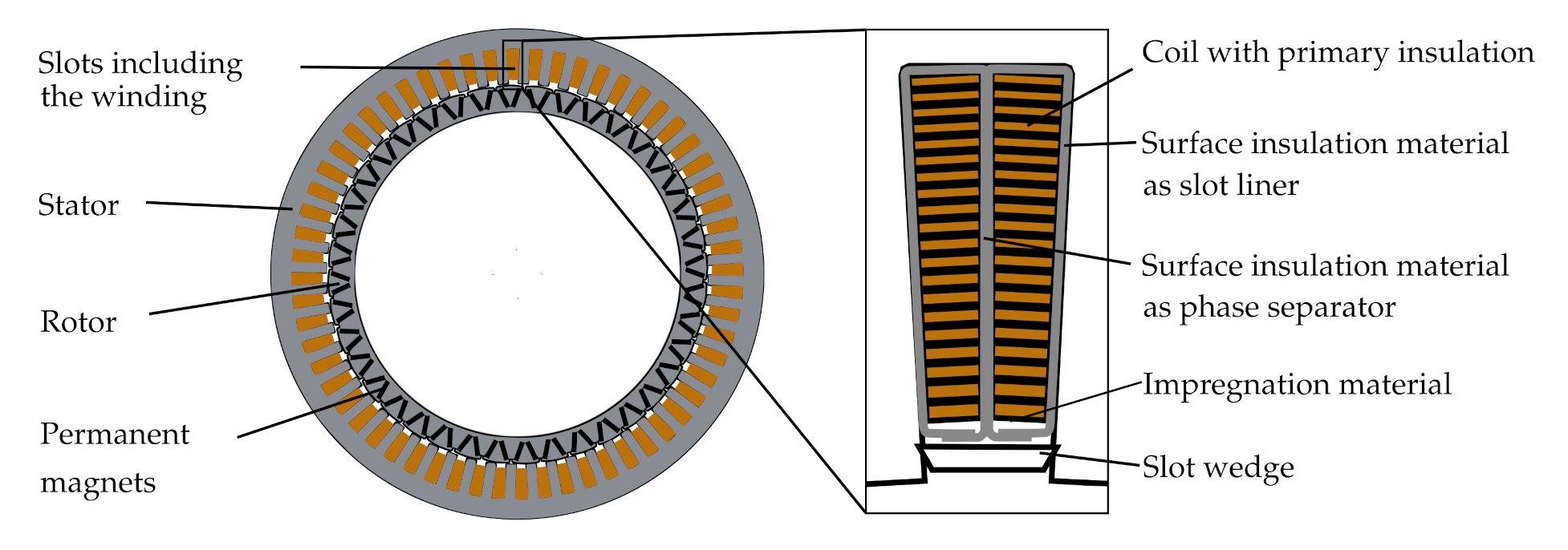
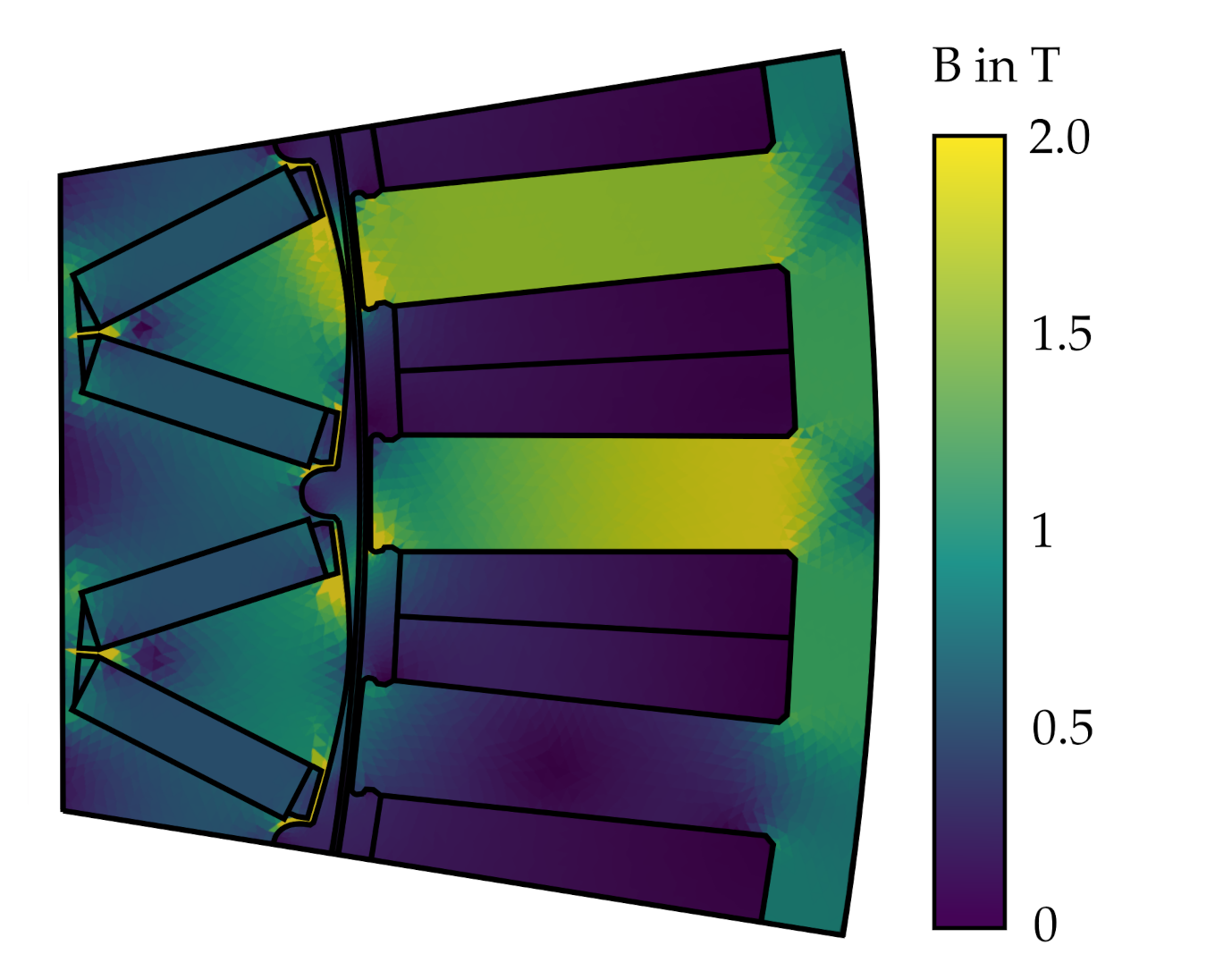
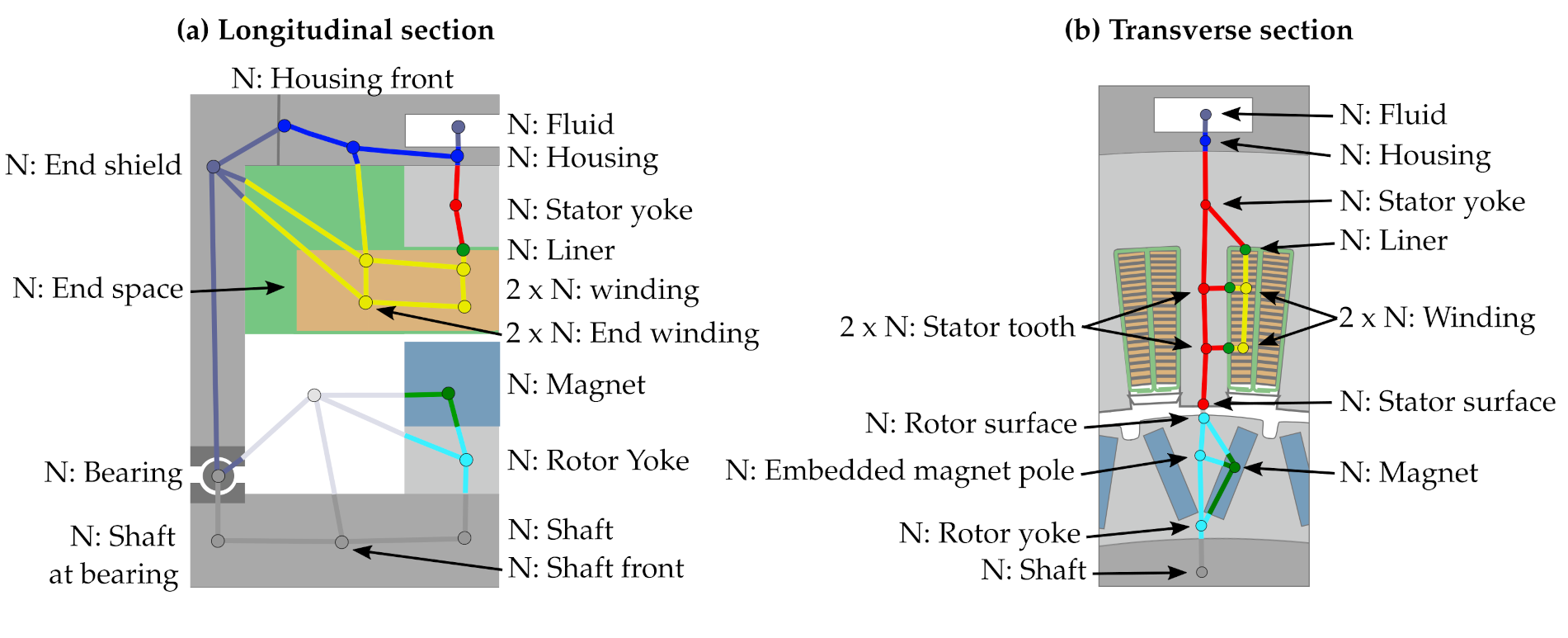

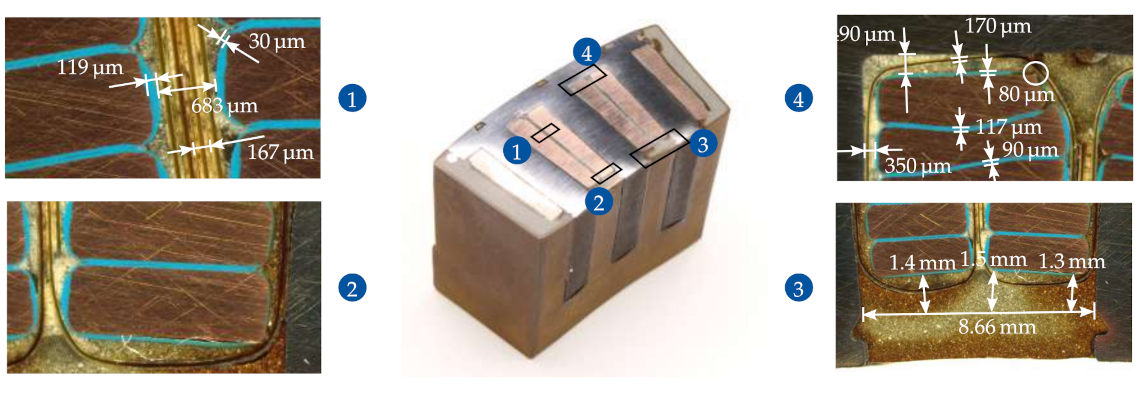
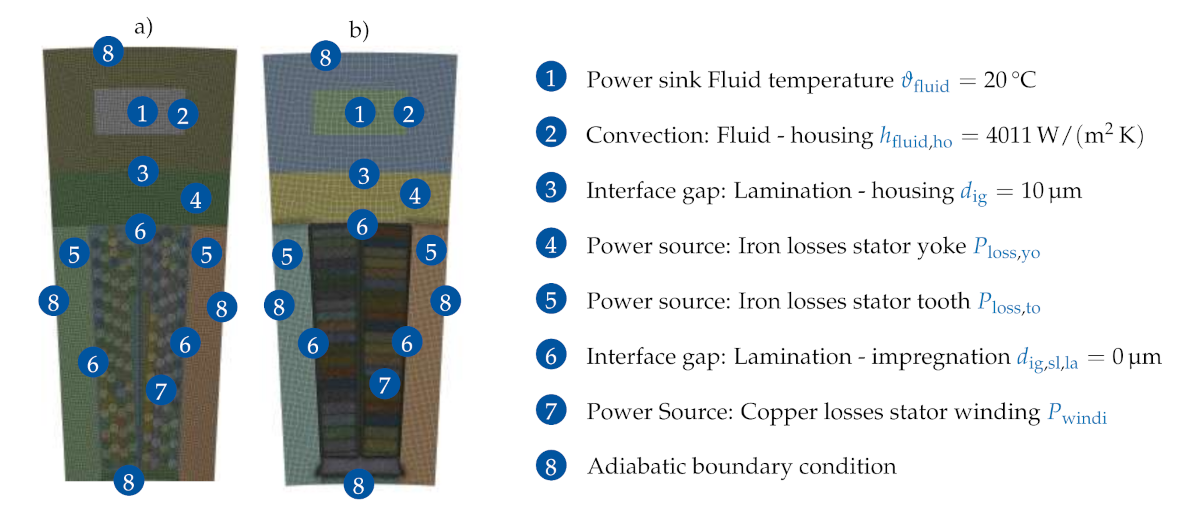
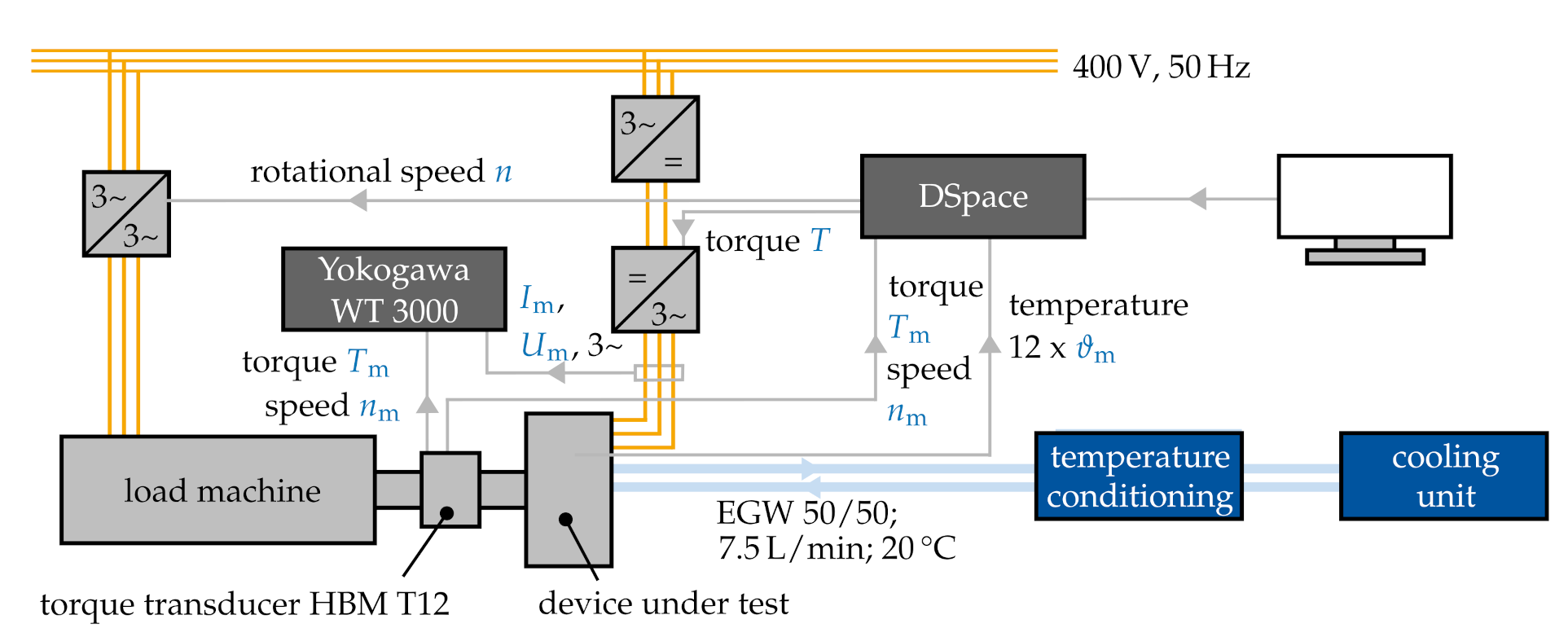
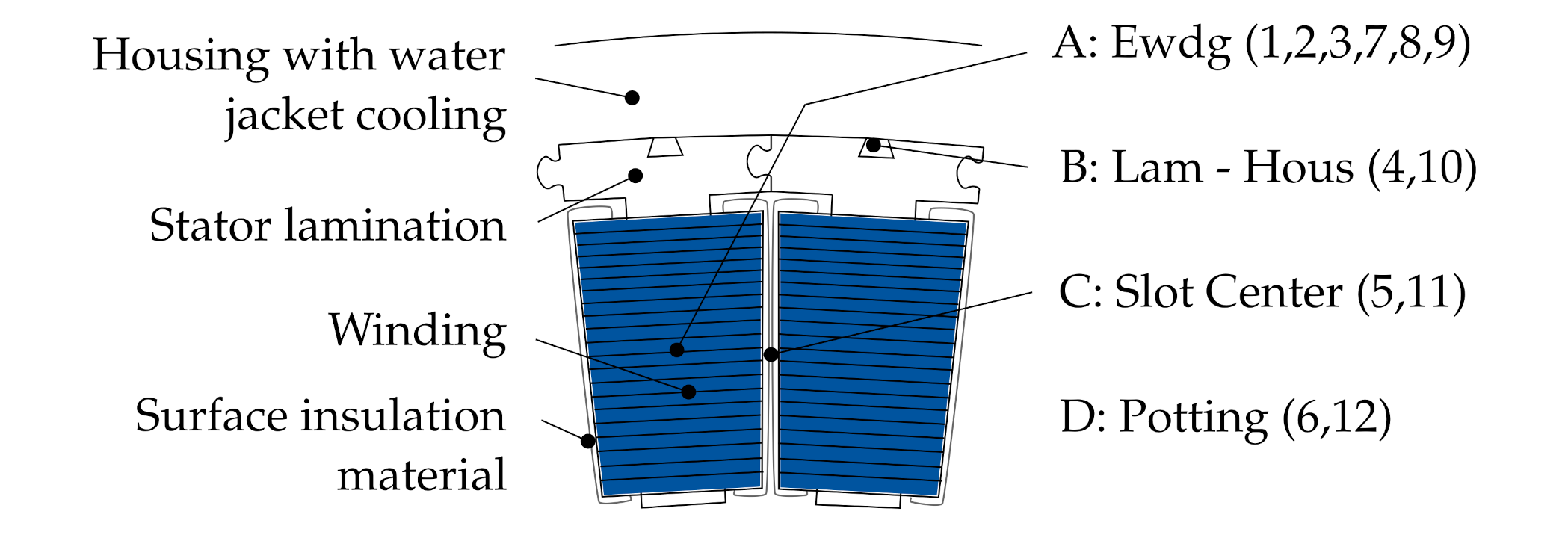
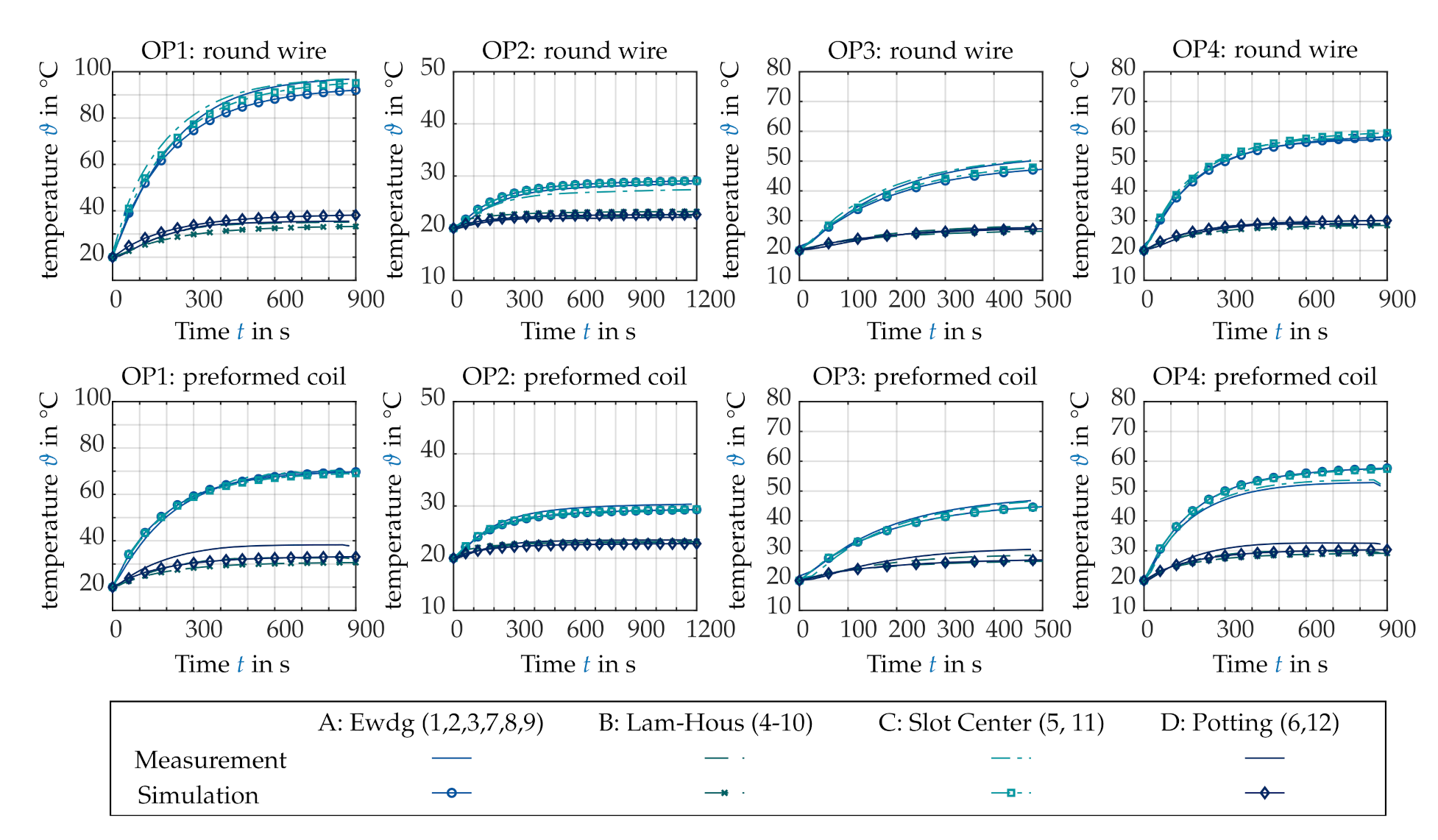
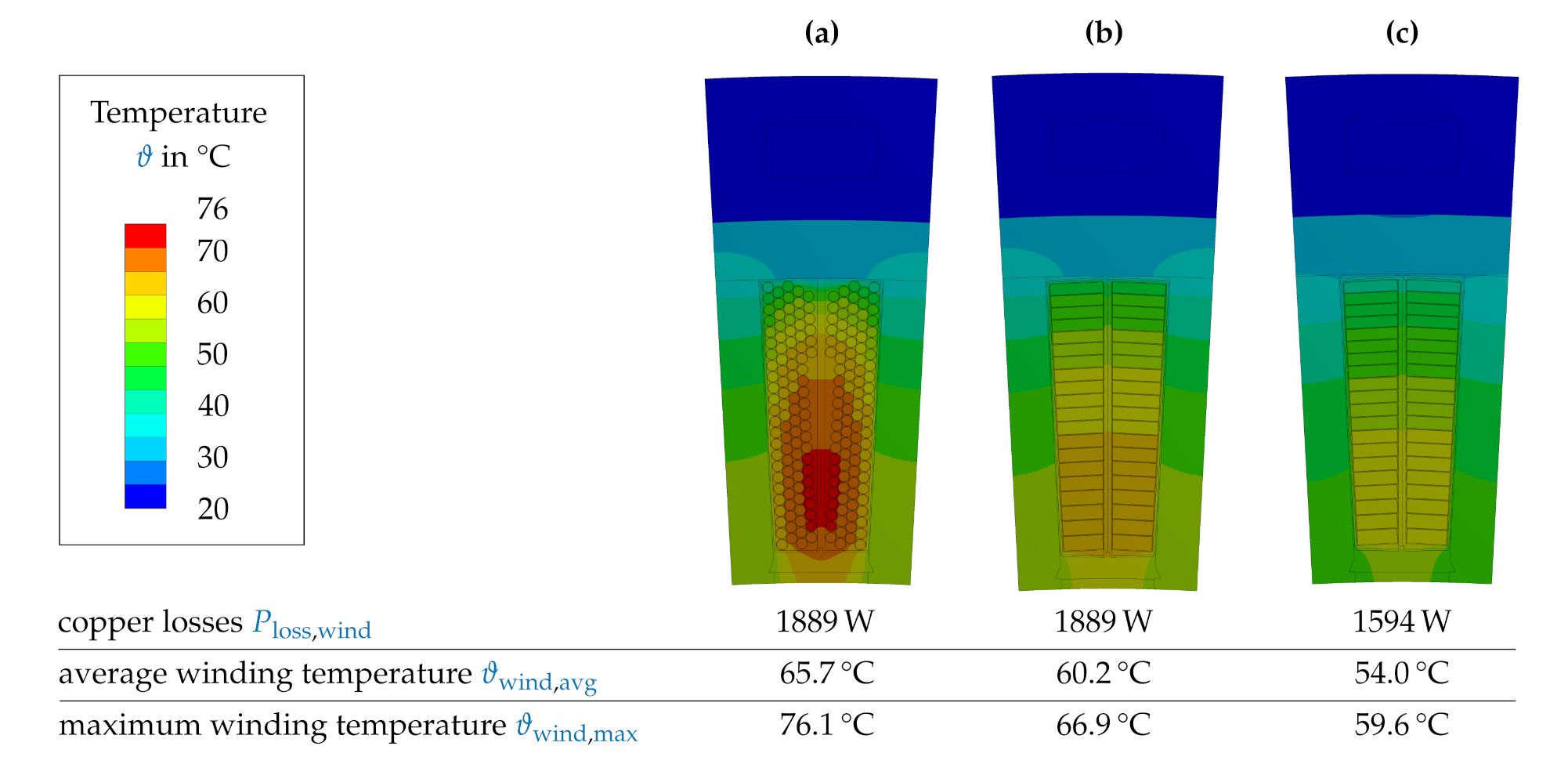

| OP | T | n | PFe,sta,to | PFe,sta,yo | PFe,rot,emp | PFe,rot,yo | Pwind,round | Pwind,pref |
|---|---|---|---|---|---|---|---|---|
| in Nm | in rpm | in W | in W | in W | in W | in W | in W | |
| 1 | 650 | 50 | 32 | 14 | 9 | 2 | 2699 | 2277 |
| 2 | 0 | 800 | 507 | 217 | 155 | 39 | 0 | 0 |
| 3 | 400 | 800 | 515 | 222 | 152 | 38 | 905 | 894 |
| 4 | 300 | 1200 | 461 | 198 | 205 | 51 | 1275 | 1440 |
| Maximum Temperature ϑmax | Average Temperature ϑavg | |||||||
|---|---|---|---|---|---|---|---|---|
| OP1 | OP2 | OP3 | OP4 | OP1 | OP2 | OP3 | OP4 | |
| round wire design: ϑLPTN−2D − ϑFEA−2D | 0.4 | 3.1 | 3.5 | 5.4 | 0.3 | 3.1 | 3.1 | 4.5 |
| preformed coil design: ϑLPTN−2D − ϑFEA−2D | −0.4 | 3.1 | 3.3 | 4.9 | 0.0 | 3.3 | 3.1 | 4.4 |
Publisher’s Note: MDPI stays neutral with regard to jurisdictional claims in published maps and institutional affiliations. |
© 2021 by the authors. Licensee MDPI, Basel, Switzerland. This article is an open access article distributed under the terms and conditions of the Creative Commons Attribution (CC BY) license (http://creativecommons.org/licenses/by/4.0/).
Share and Cite
Groschup, B.; Pauli, F.; Hameyer, K. Influence of the Preformed Coil Design on the Thermal Behavior of Electric Traction Machines. Energies 2021, 14, 959. https://doi.org/10.3390/en14040959
Groschup B, Pauli F, Hameyer K. Influence of the Preformed Coil Design on the Thermal Behavior of Electric Traction Machines. Energies. 2021; 14(4):959. https://doi.org/10.3390/en14040959
Chicago/Turabian StyleGroschup, Benedikt, Florian Pauli, and Kay Hameyer. 2021. "Influence of the Preformed Coil Design on the Thermal Behavior of Electric Traction Machines" Energies 14, no. 4: 959. https://doi.org/10.3390/en14040959






